In a pine forest on the northern edge of Kyiv one afternoon this month, Senior Sergeant Yaroslav of the Bureviy (“storm”) assault brigade gathered his rookie soldiers for a pep talk.
In no uncertain terms, he outlined the mission ahead of them. “You are being trained to assault, not to defend,” he said. “We will teach you how to attack so that Ukraine will be victorious and you might stay alive.”
The exercise was to storm and clear enemy trenches. Unloaded Kalashnikovs in hand, the troops quickly but cautiously crawled through shrubs and dirt before dropping into the maze of earthworks.
“Pop-pop!” a soldier yelled, simulating gunshots as he peeked around a corner towards a dugout. “Clear!”
Ukraine has spent months assembling a dozen new assault brigades like Bureviy, training some 40,000 new troops to bolster its forces and replace the tens of thousands of troops cut down since Russia’s full-scale invasion began 14 months ago.
It has also amassed an extensive arsenal of western weapons, from German battle tanks to US rocket launchers and UK long-range missiles, in preparation for a much-anticipated counter-offensive to wrest back territory occupied by Russia’s invasion forces.
That counter-offensive is expected to come any day now — and some say it has already started — even though President Volodymyr Zelenskyy said this week that he would like to hold off until more western weapons arrive.
A person with knowledge of Ukraine’s counter-offensive preparations said the president’s message could well have been a feint or part of a strategy to get the west to rush more weapons.
But whenever their orders come down, Ukraine’s forces will need to be fully prepared as they are likely to face significant obstacles and very real resistance.
For each day Ukraine has taken to prepare, Russia has had a day to shore up its own depleted forces and fortify its defences. Despite heavy losses, its armed forces still outnumber Kyiv’s.
The Kremlin controls some 103,600 square kilometres of land — about 18 per cent of Ukraine, an area roughly the size of half of the UK — including much of the eastern provinces of Donetsk and Luhansk, the southern provinces of Kherson and Zaporizhzhia, and all of Crimea.
Zelenskyy has been clear about what Ukraine’s ultimate goal is with the counter-offensive: the liberation of all areas of Ukraine under Russian occupation, including Crimea, and the restoration of its borders established when it gained independence from Moscow in 1991.

But behind closed doors, some top officials in Kyiv have struck what one of them described as a “very realistic and very pragmatic” tone, conceding that it is unlikely Ukraine will be able to retake all occupied land from Russia — at least this year.
Still, much is at stake for Ukraine. A successful counter-offensive could change the course of the war, shifting momentum decidedly in Ukraine’s favour, demonstrating that the war is not deadlocked and shoring up any doubts among western allies thinking of scaling back military assistance to the country.
If the blow is big enough, it could also show Russian President Vladimir Putin that his occupation of Ukraine is untenable and that his long-term bet that the west will tire of the war and backing Kyiv will not pay off.
“It is a decisive moment for us. The level of western support depends on our success,” says Andriy Sybiha, deputy head of the presidential administration. “The more we achieve on the battlefield, the more we get from our partners. And they will share that victory with us.”
Diplomatic expectations
Anything less than victory could also be momentous.
Ukraine is concerned that a counter-offensive that does not win back significant territory could lead western supporters to question future military support and pile pressure on Kyiv to enter into peace negotiations with Moscow this year.
US officials have repeatedly said they are not pushing Ukraine to negotiate with Russia and that it is up to Kyiv to decide when is the right time to open talks with Moscow. Some US officials see Ukrainian progress in a counter-offensive creating a window for talks between Russia and Ukraine, perhaps with China playing a role.

Washington welcomed a call between Zelenskyy and Chinese president Xi Jinping last month, during which Xi expressed hopes the two sides could come to the negotiating table, in Beijing’s account. On Friday, China’s foreign ministry announced that its special envoy for Eurasian affairs would soon follow that up with visits to Ukraine, Poland, France, Germany and Russia from May 15, “to make communications with all parties on the political settlement of Ukraine”.
American officials say Washington is planning to support Ukraine in a range of counter-offensive scenarios, including success, limited success, or no success at all.
A White House official says Biden has signalled his strong support for Ukraine by visiting Kyiv on the first anniversary of Russia’s full-scale invasion and that the US will support Kyiv for “as long as it takes”. “We would not describe the counter-offensive as make or break,” the White House official says.

Privately, some US officials say Ukraine will need to have some demonstrable success on the battlefield to be able to sell additional aid requests to Congress and the American public.
In Europe, support for Kyiv is “not really conditional on Ukraine making progress on the military front in the near future”, says one senior European diplomat. “But it could be important for the US to see some progress before they get into an election year. It’s not that their commitment will vanish but their attention span gets very short in an election year.”
A complex operation
While Ukraine may not enjoy the element of surprise as it did during its autumn counter-offensive, when it liberated nearly all of the eastern Kharkiv province and areas in the country’s south, including the city of Kherson, it still hopes to catch Russia off-balance.
Ukrainian military officials and soldiers who spoke on condition of anonymity in keeping with military protocol, say their forces are likely to launch a combination of counter-attacks along the frontline to test Russia’s defences, with the bigger blows coming where they sense opportunities to break through.
One area where they are likely to focus their efforts is in the southern province of Zaporizhzhia. There, if they manage to sever the “land bridge” connecting Russian territory with occupied Crimea and reach the strategic junction city of Melitopol, they could split Russia’s occupation into two. That would make it much more difficult for the occupying force to reinforce positions and shuttle supplies to and from Crimea.
The only route into the occupied peninsula then would be the Russian-built Kerch Bridge, which Ukraine attacked last October, making it temporarily impassable.

But Ukraine has a tough task after Russia has spent many months improving and expanding their fortifications in the east. Its multi-layered defences include anti-tank ditches, concrete “dragon’s teeth” barriers, razor wire and minefields.
“I don’t think they will stop Ukrainian forces but certainly they will slow them down,” says Andriy Zagorodnyuk, chairman of the Centre for Defence Strategies and a former defence minister of Ukraine.
The length of the frontline — some 960 snaking kilometres — works to Ukraine’s advantage, he adds. “Essentially, [Russian forces] are scattered around this frontline and we will always be able to find some areas where they don’t expect us.”
Ukraine’s successful counter-offensive last autumn was due at least in part to Russia’s forces being stretched thin.
Ukraine has spent the past several months collecting a vast assortment of weapons and ammunition from its western partners to be used by its assault brigades to carry out complex, combined offensive operations that will try to punch through Russian defences.
Among the arms are main battle tanks, including German Leopard 2s and one company of British Challenger 2s, as well as American Bradley Fighting Vehicles and High Mobility Artillery Rocket System (Himars). The UK this week confirmed it was sending Storm Shadow cruise missiles to Ukraine, giving it a long-range strike capability for the first time.
Tanks and the spring offensive

With Ukrainian forces having made some decisive advances before winter set in, Kyiv and its allies raced to establish the new tank force in time for a possible critical offensive
But Ukraine’s depleted air force means that it will have to conduct its attacks without close air support. Furthermore, using everything the west provided to Ukraine together in a combined operation can be tricky, especially with inexperienced troops, experts say.
“It takes a lot of training, it takes a lot of unit cohesion to pull off this very complex type of operation,” says Rob Lee, a senior fellow at the Foreign Policy Research Institute. “And for Ukraine, you have these new units that have not had as much time to train as they’d like on the new Nato equipment or to train as an assault unit.”
But Russia faces significant challenges of its own. Its munitions stocks may be depleted from trying to capture Bakhmut, Lee says, and its defences rely on large numbers of mobilised troops with little combat experience.
“A lot of them have been just holding trenches,” he says. “So a lot of these mobilised units, will they stay in the fight, or will they run?”
Time to act
On the ground in Ukraine, there are signs the counter-offensive is imminent.
Ukrainian officials and analysts say that the small counter-attacks this week on the outskirts of the eastern city of Bakhmut, where the longest and bloodiest battle of the war grinds on, were part of the military’s efforts to test some of its newly trained units, including those equipped with western arms, and to probe for weak spots in Russia’s defences.
The assaults, on Russia’s northern and southern flanks there, saw Ukraine regain small but important footholds. “Such a breakthrough in one day is very substantial,” says Serhii Kuzan, chair of the Ukrainian Security and Cooperation Centre think-tank in Kyiv.
Still, it is clear that the looming battle will be a difficult one for Ukraine — and it represents an opportunity that may not be repeated.

The counter-offensive “may be the moment when available western military equipment, training and ammunition best intersect with the forces set aside by Ukraine for this operation,” Lee and Michael Kofman, director of Russia Studies at the CNA think-tank, wrote in Foreign Affairs magazine.
“Time is not on Ukraine’s side,” says the senior European diplomat. “Russia has the upper hand in the long haul.”
Zagorodnyuk, the former Ukraine defence minister, cautions against calling it a make-or-break moment. “I don’t think it’s Ukraine’s last chance. It’s a chance,” he says. “But we should not expect this to be the end of the story. We can’t realistically talk about ending the war with one counter-offensive.”
Additional reporting by Roman Olearchyk in Kyiv
Cartography by Steven Bernard
Credit: Source link










